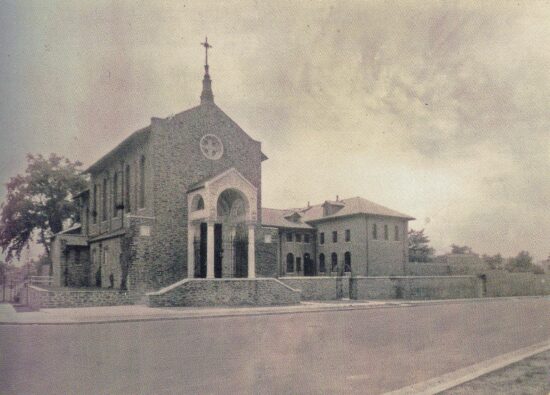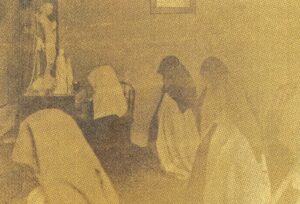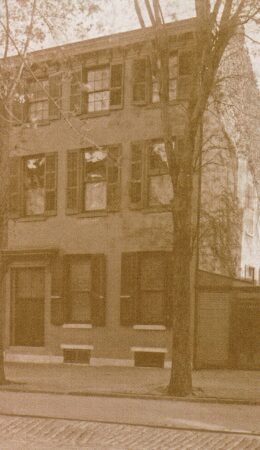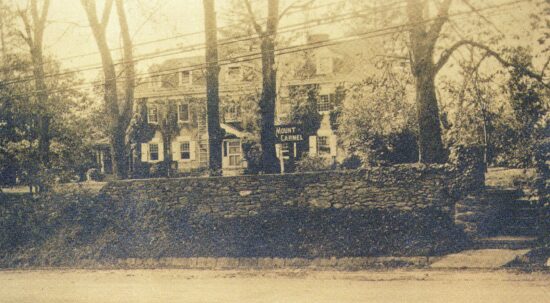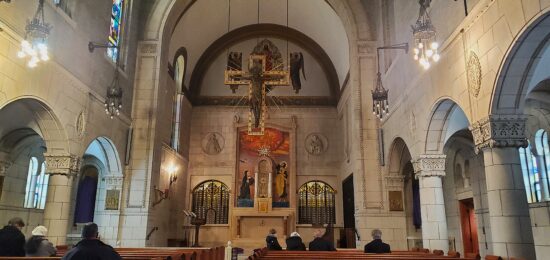Over a century ago in 1902, four Discalced Carmelite nuns arrived in Philadelphia from Boston in order to establish a monastery. Recently, a large number of Philadelphians had applied to enter the Boston Carmel, so the community saw the City of Brotherly Love as a new home for the contemplative order. They were accompanied by Mother Beatrix of the Holy Spirit (Camilla Magers), the Prioress of the Boston Carmel. The thought of Philadelphia having a contemplative order had been floated around by Bishop John Neumann, but his council advised against it due to the large amount of anti-Catholic sentiment in the city. Around the turn of the 20th century, Mrs. Mary McGeogh sought permission from Archbishop John Ryan to urge the Boston Carmel to send a group to establish a monastery. He would only give permission if the group had a property to use. Mrs. McGeogh’s father, Joseph Penn, donated a home located on the 1500 block of Poplar Street. On July 26, 1902, the fifth Carmelite monastery in the United States was established: the Carmelite Monastery on Saint Joseph and Saint Anne.
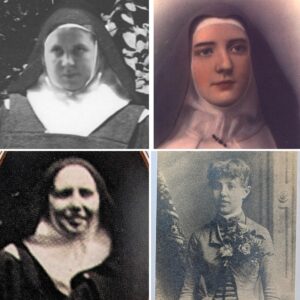
The four Foundresses: Sr. Mary of St. Joseph, Sr. Stanisalus of the Blessed Sacrament, Sr. Xavier of the Angels, Sr. Gertrude of the Heart of Jesus
It would be wrong not to mention the four foundresses of the Philadelphia Carmel, all of which had connections to the Philadelphia area. Sister Stanislaus of the Blessed Sacrament (Helen Kelly) was born in 1879 and entered the Boston Carmel at the age of 16. She also entered at the same time as Sister Mary of St. Joseph. Both girls had been parishioners of the Church of the Gesú and educated by the Sisters of Notre Dame de Namur. During her postulancy, Sister Stanislaus began to translate the autobiography of Saint Therese of Lisieux from French in to English. Upon arriving in Philadelphia, her along with Sister Mary of St. Joseph (Mary Daily), were assigned the role of portress, which allowed them to meet the public and spread the message and devotion the Little Flower. Through correspondence with Mother Agnes of Jesus, the older sister of Sant Therese, the Philadelphia Carmel became the repository for “thousands of booklets, pictures and articles related to Saint Therese … relics were obtained from Lisieux and given to the sick and suffering and many were the favors obtained.” Mother Gertrude of the Heart of Jesus (Gertrude McMaster) was the daughter of James McMaster, the editor of the Freeman’s Journal. While not born in the vicinity of Philadelphia, Gertrude was educated by the Society of the Holy Child of Jesus at Holy Child Academy in Sharon Hill. She entered the Baltimore Carmel and, in 1890, travelled with Mother Beatrix to establish the Boston Carmel. When the Carmelites came to Philadelphia, Mother Gertrude was elected as the first Prioress. Due to her failing health, she renounced her role of Prioress in 1912, passing away a year later. Sister Xavier of the Angels (Mary Otillia McGeogh) was the daughter of Mary McGeogh, the layperson who persuaded the Archbishop to establish the Philadelphia Carmel. Of the four Foundresses, Sister Xavier was the only one to see the completion of the Oak Lane monastery before passing away in 1930.
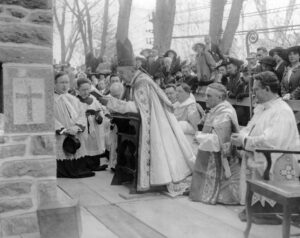
Archbishop Prendergast giving benediction at the laying of the cornerstone for the new monastery, 9/26/1915
Two years after its founding, the Poplar Street location was proving to be inadequate. Like the early American pioneers, the nuns looked west and found a home across the Schuylkill River at 44th and Spruce Streets. The location had once been part of the Satterlee Hospital, a hospital used during the American Civil War and staffed by the Daughters of Charity. This new home was more spacious than their previous location, although the home would not serve as a full-fledged convent. When the time came to expand, the Order looked to purchase the adjoining property. However, it was determined that the uneven ground of the property would be costly to level. In the summer of 1910, a new home was found in the Oak Lane neighborhood: a colonial home called Hill Top. The new site was ideal for the Carmelites, as it was both spacious and far from the hustle and bustle of the city to live their contemplative vocation. The chapel, built in the Italian Byzantine style, was dedicated by Archbishop Edmund Prendergast on September 26, 1915 with a crowd of 10,000 onlookers. One of the main obstacles facing the nuns was the construction of 66th Avenue and have it extended through the monastery property. They tried to get the City planners to reconsider this, but the efforts failed and it was decided to have the chapel and monastery face the new street. The original plan was for the structures face Old York Road with a spacious enclosed garden to the north. A momentous occasion came in 1925 with the the completion of the enclosure wall. This, according to the structural requirements for Papal enclosures, the nuns were permitted to make solemn vows. In March of that year, on the Feast of Saint Joseph, thirteen nuns and Mother Beatrix made their solemn vows in the presence of Cardinal Dougherty. In 1927, the chapel was solemnly consecrated by Dennis Cardinal Dougherty.
Much like how the Philadelphia Carmel grew out of the Boston Carmel, nuns were called from the City of Brotherly Love to establish new Carmels. Starting in the mid 1920s, five new Carmels were established in Wheeling, Rochester, Louisville, Mobile, and Savannah. It seems that the nuns had been taking to heart the words of James Cardinal Gibbons at the 100th anniversary of the America's first Carmel in Baltimore: "Vivat, cresat, floreat vita contemplativa" -"May the contemplative life live, increase and flourish among us."
References used:
Carmel In the City of Brotherly Love, 1902-1952. P006.026
Dash, Allen. Carmel in Philadelphia: The First Hundred Years, Carmelite Monastery, Philadelphia, 2002. P023.049
Official Jubilee Volume; 1890-1940, Fifty Years of Notable Achievement in the Life of His Eminence Dennis Cardinal Dougherty. 1999.016


